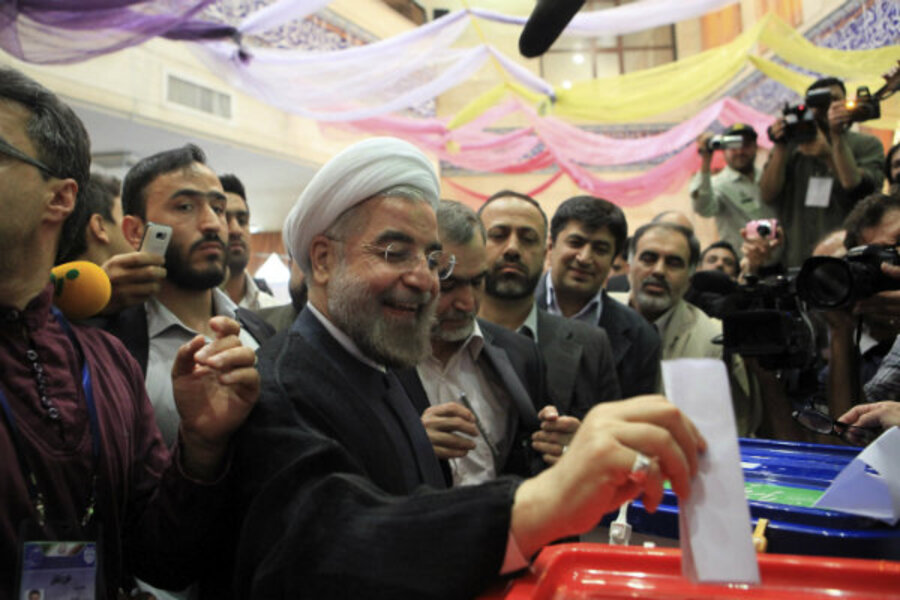Could today's Iran election be a 1975 turning point?
Loading...
| London
Is today’s presidential election in Iran a 1975 turning point?
That was the year when the shah of Iran, who seemed at the zenith of his power, decided to take down the facade of democracy that had been hiding the dictatorial nature of his regime. He dissolved the two political parties, popularly nicknamed “Yes” and “Yes, Sir,” and replaced them with a single “Yes, Sir” party, called Resurrection. It set him on the road to his own downfall.
With this move, the shah basically gave Iranians three options: Join the party, leave the country, or go to prison. But Iranians recognized that a single party meant the end of any hope that the government would permit democratic reform. Overthrowing the regime became the only logical alternative for a people yearning for independence, freedom, and democracy. This simmering discontent eventually burst out in the 1979 revolution, by which nearly 3,000 years of monarchic despotism were brought to an end.
But the democratic revolution of nearly 35 years ago was hijacked by the ayatollahs, and now, Supreme Leader Ayatollah Ali Khamenei may be walking in the path of the hated shah.
As the shah abolished the two-party system, so has Mr. Khamenei abolished any semblance of a competitive slate of candidates for today’s election. The Iranian Guardian Council, which vets presidential candidates, has eliminated those candidates who might have been perceived as having a reform or independent streak in them, including former President Akbar Hashemi Rafsanjani, whom the council declared unfit to run – to the dismay of reformists.
The most obvious reason for a slate full of conservative Khamenei loyalists is to avoid the upheaval that followed the 2009 presidential election. That was when many Iranian voters backed a reformer, Mir-Hossein Mousavi, and then took the streets to protest vote rigging and fraud when he lost. The demonstrators’ “green movement” was violently put down by the regime.
Despite Khamenei’s slate of “Yes, Sir” candidates, those who wear the reform label, such as Mr. Rafsanjani, have found someone to endorse on the list of six candidates.
His name is Hassan Rouhani, a cleric and former nuclear negotiator. He is trying to appeal to women voters and ethnic minorities, saying that he’ll form a ministry of women. His appeal also lies in his foreign policy experience as a former nuclear negotiator. With the help of reformsits as well as some conservatives, Mr. Rouhani is trying to garner a following among young Iranians.
Hopefully, voters will understand that Rouhani is a thoroughly conservative loyalist, highly unlikely to deliver any loosening of the Islamic security apparatus. He enthusiastically endorsed the crackdown on students in the uprising of 1999. If he is “elected” (in reality, appointed by Khamenei, if that’s his choice in these fraudulent elections), reform-minded Iranians will be just as disappointed as with reformist Rafsanjani.
After all, during Rafsanjani’s time as head of the parliament and later on as the president, in the 1980s and early 1990s, thousands of prisoners were executed and many of the regime’s opponents were assassinated. In 1997, German prosecutors implicated Rafsanjani and Khamenei in ordering the assassination of dissident Iranian-Kurdish leaders in the Mykonos restaurant in West Berlin in 1992.
Voters will likely recognize Khamenei’s “Yes, Sir” list for what it is, just as they did the fraudulent election in 2009, and the shah’s one-party move in 1975. But given the certainty of a crackdown on any post-election protest, they would be better off this time with boycotting the elections – denying the regime the legitimacy that it tries to demonstrate through multiple candidates and a supposed “winner.”
A mass boycott could, in turn, embolden Khamenei’s opponents within the regime and in society, potentially having a snowball effect. It would also send a message to Western governments, primarily the United States, that Iranians want to see the back of this regime and they are the masters of their house.
It’s difficult to predict how Iranians will react to this election. The peeling back of even the veneer of political choice and change may be the last straw for Iranians and eventually lead to another uprising, just as the shah’s move did in 1975.
For more than a century, social movements in Iran have attempted to realize the goal of more freedom. A point comes when oppression can be withstood no longer, when people feel they have nothing more to lose. This may still turn out to be that point.
Mahmood Delkhasteh is a political and human rights activist. He is working on a book based on his doctoral dissertation, “Islamic Discourses of Power and Freedom in the Iranian Revolution, 1979-81.”





